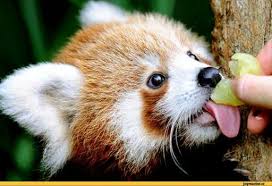
Etymology
The first written mention of the lesser panda dates back to the 13th century, but Europeans did not encounter it until the 19th.
The English general Thomas Hardwicke in 1821 collected materials about this animal for the first time in the history of zoology.
He suggested that this animal be called "wah," one of its Chinese names, based on the imitation of the sounds the animal makes. In addition, the general said, the Chinese call it huo-hu and the Nepalese call it poonya, from which the modern panda is derived.
The Latin name of this animal, Ailurus fulgens, which can be translated as "shining cat," was given to the new animal by French naturalist Frederic Cuvier. The British scientific community was enraged by such "theft", but according to the rule adopted by the naturalists themselves once the scientific name given to the organism can no longer be changed. And the "discoverer" of the species is considered to be the one who gave it this name.
Description
The body length of the lesser panda is 51-64 cm, the tail can be up to 48 cm long. Male red pandas weigh 3.7-6.2 kilograms, while females can weigh up to 6 kilograms.
The body is elongated, the tail is fluffy, the head is broad, with a short sharp muzzle and small rounded ears. It has 38 teeth. Its paws are short, strong, and have semi-retractable claws that help the panda easily climb up and down trees.
The red panda's fur is red or hazel on top and dark, reddish-brown or black underneath. The back hair has yellow tips. Paws are glaucous-black, tail is red with little noticeable lighter, narrow rings, head is light, and edges of ears and muzzle are almost white, and near eyes is drawing in form of mask, as at raccoons, and this drawing is unique for each separate specimen. This is a wonderful camouflage for an animal that spends most of its time in trees covered with moss and lichens.
Lifestyle
The lesser panda is nocturnal, sleeping in a hollow in the daytime and awake at night. In case of danger, it climbs trees. On the ground, the lesser panda is clumsy, but moves swiftly and deftly through the trees.
When quiet, the little panda makes short sounds resembling bird chirps.
The lesser panda is peaceful and easily acclimated in captivity.
Nutrition
95% of the diet of the lesser panda is vegetation, including young leaves and bamboo shoots. The remaining 5% are fruits, berries, mushrooms, bird eggs, and small animals.
Reproduction
Pandas' breeding season is in January. Between mating and giving birth, the female panda takes 90 to 145 days, of which only 50 days are spent actually developing an embryo, because the fetus does not develop immediately after conception, but rather after a short period of time called diapause.
Males rarely take part in rearing calves, except in the family Musteloidea. The family Ailuridae is isolated from the raccoon family and includes one modern genus with one species, the red panda, as well as its extinct relatives from other genera (they have the traits of all the above families).
Subspecies
Western Lesser Panda (Ailurus fulgens fulgens) - Found in western China, as well as Nepal and Bhutan.Stiana Lesser Panda - Found in southern China and northern Myanmar.
Lesser panda and humans
The lesser panda has very few natural enemies, but the species is listed in the International Red Book with "endangered" status. Its population density in the wild is low, and deforestation poses a threat to the population, as does poaching. Over the past 50 years, the red panda population in the Himalayan Mountains has decreased by 40%.
Protecting the species and keeping them in captivity
Fortunately, the lesser panda breeds well in captivity. Currently there are about 350 of these animals in 85 zoos worldwide and an equal number have been born in captivity over the past two decades. However, the number of baby pandas in one litter is usually no more than two, and they are born only once a year. Therefore, the population of small pandas is still threatened, and in their natural habitat their mortality rate is very high.
These cute little animals are well tame and delight visitors to zoos with their charming appearance.
Also in some regions of India and Nepal, small pandas are kept as pets, which is totally unacceptable for this animal. Keeping them even in zoos is very difficult, and in domestic conditions and simply impossible: too specific diet is needed for the red panda. And if not fed properly, these animals quickly die of intestinal diseases.
The lesser panda in culture
Master Shifu from the Kung Fu Panda comedy franchise is a small panda. However, his fur coloring is more like that of a giant panda.Confucius, the main character in the m/f "Brave Big Panda".The fire ferret Pabu from the animated series "Avatar: The Legend of Korra" is drawn from a small panda.The small panda was also mentioned in the anime series "Katekyo Hitman Reborn!"The game character Brewmaster and Redpaw Courier from the computer game Dota 2 are the embodiment of




You must be logged in to post a comment.